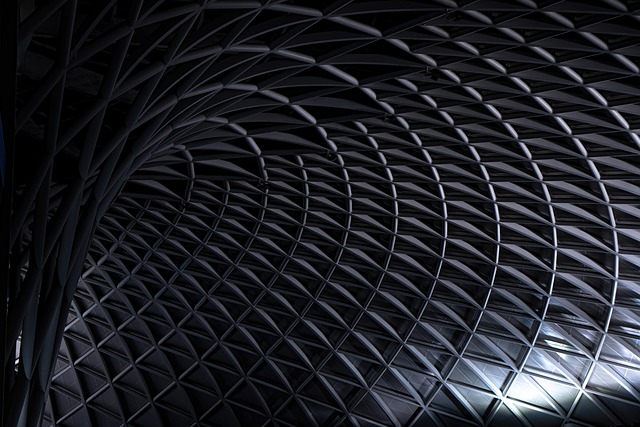Cool roof technology, leveraging light-colored asphalt shingles with advanced coatings, is a revolutionary approach in sustainable building design. By reflecting sunlight and reducing heat absorption, it combats urban heat islands, lowers interior temperatures, and decreases energy demands for cooling. This eco-friendly solution offers significant cost savings and environmental benefits, especially in hot climates, where it mitigates the heat island effect, extends roofing lifespan, and promotes sustainability by reducing carbon emissions. Effective implementation requires prioritizing reflectivity, proper ventilation, high-quality materials, regular cleaning, and sealing techniques to maximize energy efficiency.
In today’s quest for energy efficiency, cool roof technology emerges as a prominent solution. This innovative approach involves utilizing light-colored asphalt shingles, designed to reflect sunlight and reduce heat absorption. By understanding how this technology works, homeowners and builders can unlock significant benefits in temperature control, leading to lower cooling costs and reduced environmental impact. This article delves into the science behind cool roofs, exploring the role of light-colored shingles, their impact on temperature regulation, and practical considerations for installation.
Understanding Cool Roof Technology: An Overview
Cool roof technology is a revolutionary approach designed to reduce the amount of heat absorbed by roofing materials, thereby lowering building temperatures. This innovative solution has gained significant attention in recent years due to its potential to mitigate urban heat island effects and improve energy efficiency. By reflecting sunlight and emitting heat, cool roofs help maintain comfortable indoor environments while reducing the demand for air conditioning.
At its core, cool roof technology involves using specialized materials that have superior thermal reflective properties. These materials are typically light-colored asphalt shingles, engineered with advanced coatings or surfaces that minimize heat absorption. This simple yet effective method allows buildings to stay cooler during hot weather conditions, leading to reduced energy consumption and lower greenhouse gas emissions.
The Role of Light-Colored Asphalt Shingles
Light-colored asphalt shingles play a significant role in achieving better temperature control for your home or building, especially when combined with cool roof technology. These shingles are designed to reflect a higher percentage of sunlight and heat away from the structure, thereby reducing the amount of thermal energy absorbed. This is particularly beneficial in regions with hot summers, where traditional dark-colored shingles can significantly increase interior temperatures due to heat absorption.
The use of light-colored asphalt shingles is a practical implementation of cool roof technology. By reflecting rather than absorbing sunlight, these shingles help maintain a lower roof temperature, which can lead to reduced energy consumption for cooling and improved overall thermal comfort inside the building. This simple yet effective solution contributes to both environmental sustainability and cost savings.
How Light Colors Affect Temperature Control
Light-colored asphalt shingles are a popular choice for roofing materials, especially in regions with hot climates, thanks to their significant role in temperature control. This is largely due to what’s known as cool roof technology—a concept that leverages the impact of color and material on heat absorption and reflection. Dark colors absorb more sunlight and, consequently, generate more heat, while light colors do the opposite; they reflect most of the sun’s rays, keeping the building below cooler.
In terms of practical application, roofs made with light-colored shingles can help reduce the overall temperature inside buildings during summer months, thereby decreasing energy consumption for cooling. This is especially beneficial in urban areas known for their ‘heat island’ effect, where blacktop roofs contribute to elevated temperatures. By adopting cool roof technology, homeowners and building managers can create more energy-efficient spaces, leading to potential cost savings and environmental benefits.
Benefits of Implementing Cool Roofs
Implementing cool roofs, equipped with light-colored asphalt shingles, offers a multitude of benefits for both residential and commercial properties. In regions with hot climates, these roofs can significantly reduce indoor temperatures by reflecting sunlight rather than absorbing it, thereby lowering cooling costs and energy consumption. This eco-friendly approach not only minimizes the urban heat island effect but also extends the lifespan of roofing materials by decreasing exposure to intense heat.
Moreover, cool roof technology contributes to a more sustainable and resilient built environment. By reducing peak demand for air conditioning, these roofs help alleviate strain on local power grids and lower carbon emissions. They also provide homeowners with the opportunity to improve indoor comfort while enjoying potential tax incentives and utility bill savings, making them a smart investment in both environmental stewardship and economic sense.
Considerations and Best Practices for Installation
When installing light-colored asphalt shingles, or implementing cool roof technology, there are several considerations to ensure optimal temperature control and performance. One key aspect is reflecting sunlight; lighter colors reflect heat better than darker shades, which absorb it. Therefore, choosing reflective materials and maintaining a clean installation surface is crucial for maximum energy efficiency.
Best practices include proper ventilation to reduce heat buildup, ensuring the underlayment is in good condition, and using high-quality, certified cool roof products. Regular maintenance, such as cleaning the roof to maintain reflectivity, and checking for any damage or moisture intrusion, is essential. Proper installation techniques, including sealing all edges and corners, also contribute to the overall effectiveness of this green building solution.
Light-colored asphalt shingles offer an effective solution for improving temperature control in buildings. By adopting cool roof technology, which leverages the reflective properties of lighter shades, we can significantly reduce energy consumption and mitigate the urban heat island effect. The benefits are clear: lower cooling costs, improved indoor comfort, and a smaller environmental footprint. When considering installation, it’s crucial to follow best practices and account for factors like local climate and shading conditions. Embracing cool roof technology is not just an intelligent choice for property owners; it’s a step towards a more sustainable future.
